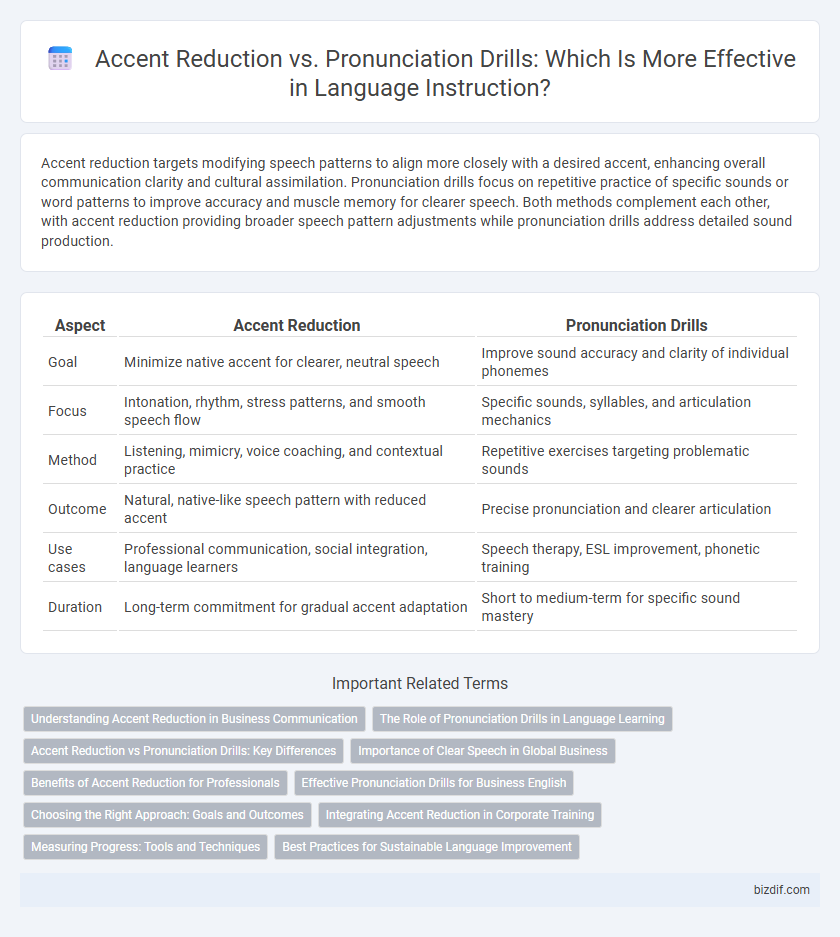Accent reduction targets modifying speech patterns to align more closely with a desired accent, enhancing overall communication clarity and cultural assimilation. Pronunciation drills focus on repetitive practice of specific sounds or word patterns to improve accuracy and muscle memory for clearer speech. Both methods complement each other, with accent reduction providing broader speech pattern adjustments while pronunciation drills address detailed sound production.
Table of Comparison
| Aspect | Accent Reduction | Pronunciation Drills |
|---|---|---|
| Goal | Minimize native accent for clearer, neutral speech | Improve sound accuracy and clarity of individual phonemes |
| Focus | Intonation, rhythm, stress patterns, and smooth speech flow | Specific sounds, syllables, and articulation mechanics |
| Method | Listening, mimicry, voice coaching, and contextual practice | Repetitive exercises targeting problematic sounds |
| Outcome | Natural, native-like speech pattern with reduced accent | Precise pronunciation and clearer articulation |
| Use cases | Professional communication, social integration, language learners | Speech therapy, ESL improvement, phonetic training |
| Duration | Long-term commitment for gradual accent adaptation | Short to medium-term for specific sound mastery |
Understanding Accent Reduction in Business Communication
Accent reduction in business communication emphasizes minimizing regional or foreign speech patterns to enhance clarity and professionalism, whereas pronunciation drills target specific sounds for accuracy. Effective accent reduction involves mastering intonation, rhythm, and stress patterns critical for clear message delivery in corporate settings. Integrating both methods improves overall intelligibility and fosters better cross-cultural interactions in the global marketplace.
The Role of Pronunciation Drills in Language Learning
Pronunciation drills play a crucial role in language learning by systematically targeting individual sounds, intonation patterns, and stress to enhance clarity and comprehensibility. These exercises support accent reduction by helping learners internalize standard phonetic rules and develop muscle memory for accurate articulation. Consistent practice with pronunciation drills leads to improved oral communication skills and greater confidence in speaking.
Accent Reduction vs Pronunciation Drills: Key Differences
Accent reduction focuses on modifying speech patterns to align with a target accent by addressing intonation, rhythm, and stress, enhancing overall comprehensibility. Pronunciation drills concentrate on mastering individual sounds and phonemes through repetitive exercises, improving clarity at the word level. Understanding these differences helps learners choose the appropriate method for achieving communication goals effectively.
Importance of Clear Speech in Global Business
Clear speech is crucial in global business as it ensures effective communication, reduces misunderstandings, and fosters professional relationships across diverse linguistic backgrounds. Accent reduction focuses on modifying speech patterns to align with standard pronunciation, enhancing clarity and confidence in international settings. Pronunciation drills target specific sounds and phonetic skills to improve accuracy, supporting clear articulation and comprehension in global business interactions.
Benefits of Accent Reduction for Professionals
Accent reduction offers professionals improved clarity and confidence in communication, enhancing workplace interactions and leadership presence. It helps reduce misunderstandings and fosters stronger relationships with diverse colleagues and clients, supporting career advancement. Consistent accent training also improves overall speech intelligibility, making presentations and negotiations more effective.
Effective Pronunciation Drills for Business English
Effective pronunciation drills for Business English emphasize targeted practice of vowel and consonant sounds critical to professional communication, enhancing clarity and reducing misunderstandings. Incorporating rhythm, intonation, and stress patterns specific to business contexts improves listener comprehension and engagement. Regular, focused exercises using real-world business vocabulary and scenarios accelerate accent reduction and boost speaker confidence in corporate interactions.
Choosing the Right Approach: Goals and Outcomes
Accent reduction targets modifying speech patterns to enhance clarity and reduce regional or foreign influence, focusing on intonation, rhythm, and stress, while pronunciation drills concentrate on accurate articulation of individual sounds and phonemes. Selecting the right approach depends on the learner's goals: accent reduction suits professionals seeking improved intelligibility and cultural assimilation, whereas pronunciation drills benefit beginners aiming to master basic sound production. Effective language instruction often combines both to balance natural communication with linguistic precision.
Integrating Accent Reduction in Corporate Training
Integrating accent reduction into corporate training enhances clear communication by focusing on reducing specific regional or non-native speech patterns that hinder effective interaction. Pronunciation drills target individual sounds and stress patterns, but accent reduction encompasses broader phonetic adjustments and intonation, improving overall comprehensibility in professional settings. Tailored programs combining both methods boost employee confidence and facilitate seamless collaboration across diverse teams.
Measuring Progress: Tools and Techniques
Measuring progress in accent reduction involves tools such as spectrogram analysis and native speaker feedback, which provide objective and qualitative data on speech clarity and phonetic accuracy. Pronunciation drills are assessed using software applications that track phoneme accuracy, intonation patterns, and stress placement, enabling learners to visualize improvements over time. Combining acoustic analysis with learner self-assessment enhances the precision of progress evaluation in both methodologies.
Best Practices for Sustainable Language Improvement
Accent reduction emphasizes modifying speech patterns to sound more native-like by focusing on intonation, rhythm, and stress, while pronunciation drills target the accurate production of individual sounds. Best practices for sustainable language improvement include consistent, contextualized practice integrating both methods, alongside feedback from native speakers or coaches to ensure gradual and authentic progress. Combining accent reduction techniques with focused pronunciation exercises fosters clearer communication and long-term retention.
Accent reduction vs Pronunciation drills Infographic

 bizdif.com
bizdif.com